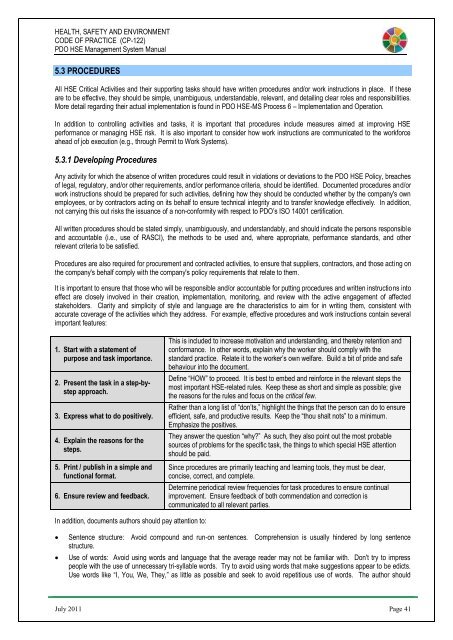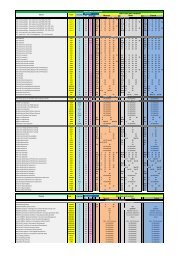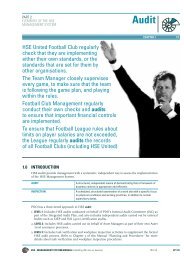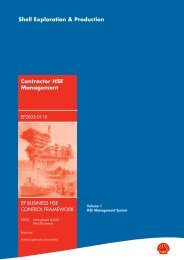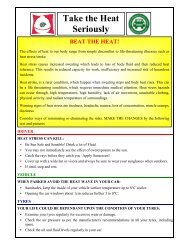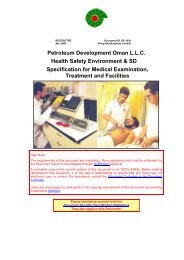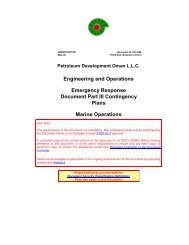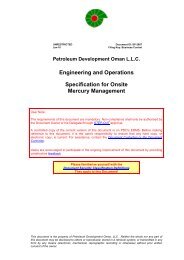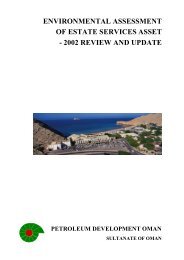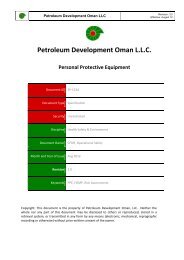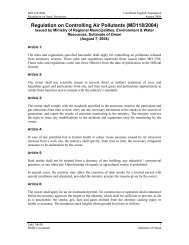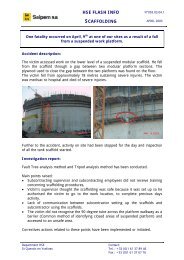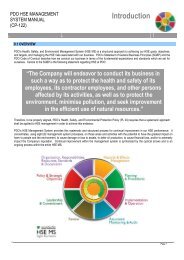CP-122 HSE Code of Practice - PDO
CP-122 HSE Code of Practice - PDO
CP-122 HSE Code of Practice - PDO
Create successful ePaper yourself
Turn your PDF publications into a flip-book with our unique Google optimized e-Paper software.
HEALTH, SAFETY AND ENVIRONMENT<br />
CODE OF PRACTICE (<strong>CP</strong>-<strong>122</strong>)<br />
<strong>PDO</strong> <strong>HSE</strong> Management System Manual<br />
5.3 PROCEDURES<br />
All <strong>HSE</strong> Critical Activities and their supporting tasks should have written procedures and/or work instructions in place. If these<br />
are to be effective, they should be simple, unambiguous, understandable, relevant, and detailing clear roles and responsibilities.<br />
More detail regarding their actual implementation is found in <strong>PDO</strong> <strong>HSE</strong>-MS Process 6 – Implementation and Operation.<br />
In addition to controlling activities and tasks, it is important that procedures include measures aimed at improving <strong>HSE</strong><br />
performance or managing <strong>HSE</strong> risk. It is also important to consider how work instructions are communicated to the workforce<br />
ahead <strong>of</strong> job execution (e.g., through Permit to Work Systems).<br />
5.3.1 Developing Procedures<br />
Any activity for which the absence <strong>of</strong> written procedures could result in violations or deviations to the <strong>PDO</strong> <strong>HSE</strong> Policy, breaches<br />
<strong>of</strong> legal, regulatory, and/or other requirements, and/or performance criteria, should be identified. Documented procedures and/or<br />
work instructions should be prepared for such activities, defining how they should be conducted whether by the company's own<br />
employees, or by contractors acting on its behalf to ensure technical integrity and to transfer knowledge effectively. In addition,<br />
not carrying this out risks the issuance <strong>of</strong> a non-conformity with respect to <strong>PDO</strong>‟s ISO 14001 certification.<br />
All written procedures should be stated simply, unambiguously, and understandably, and should indicate the persons responsible<br />
and accountable (i.e., use <strong>of</strong> RASCI), the methods to be used and, where appropriate, performance standards, and other<br />
relevant criteria to be satisfied.<br />
Procedures are also required for procurement and contracted activities, to ensure that suppliers, contractors, and those acting on<br />
the company's behalf comply with the company's policy requirements that relate to them.<br />
It is important to ensure that those who will be responsible and/or accountable for putting procedures and written instructions into<br />
effect are closely involved in their creation, implementation, monitoring, and review with the active engagement <strong>of</strong> affected<br />
stakeholders. Clarity and simplicity <strong>of</strong> style and language are the characteristics to aim for in writing them, consistent with<br />
accurate coverage <strong>of</strong> the activities which they address. For example, effective procedures and work instructions contain several<br />
important features:<br />
1. Start with a statement <strong>of</strong><br />
purpose and task importance.<br />
2. Present the task in a step-bystep<br />
approach.<br />
3. Express what to do positively.<br />
4. Explain the reasons for the<br />
steps.<br />
5. Print / publish in a simple and<br />
functional format.<br />
6. Ensure review and feedback.<br />
This is included to increase motivation and understanding, and thereby retention and<br />
conformance. In other words, explain why the worker should comply with the<br />
standard practice. Relate it to the worker‟s own welfare. Build a bit <strong>of</strong> pride and safe<br />
behaviour into the document.<br />
Define “HOW” to proceed. It is best to embed and reinforce in the relevant steps the<br />
most important <strong>HSE</strong>-related rules. Keep these as short and simple as possible; give<br />
the reasons for the rules and focus on the critical few.<br />
Rather than a long list <strong>of</strong> “don‟ts,” highlight the things that the person can do to ensure<br />
efficient, safe, and productive results. Keep the “thou shalt nots” to a minimum.<br />
Emphasize the positives.<br />
They answer the question “why?” As such, they also point out the most probable<br />
sources <strong>of</strong> problems for the specific task, the things to which special <strong>HSE</strong> attention<br />
should be paid.<br />
Since procedures are primarily teaching and learning tools, they must be clear,<br />
concise, correct, and complete.<br />
Determine periodical review frequencies for task procedures to ensure continual<br />
improvement. Ensure feedback <strong>of</strong> both commendation and correction is<br />
communicated to all relevant parties.<br />
In addition, documents authors should pay attention to:<br />
Sentence structure: Avoid compound and run-on sentences. Comprehension is usually hindered by long sentence<br />
structure.<br />
<br />
Use <strong>of</strong> words: Avoid using words and language that the average reader may not be familiar with. Don't try to impress<br />
people with the use <strong>of</strong> unnecessary tri-syllable words. Try to avoid using words that make suggestions appear to be edicts.<br />
Use words like “I, You, We, They,” as little as possible and seek to avoid repetitious use <strong>of</strong> words. The author should<br />
July 2011 Page 41


